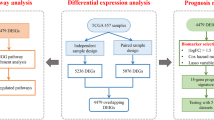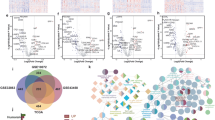Abstract
Recent studies have shown that tumor immune cell infiltration (ICI) is associated with immunotherapy sensitivity and the prognosis of lung adenocarcinoma (LUAD). However, the immunoinfiltrative landscape of LUAD has not been elucidated. We propose two computational algorithms to unravel the ICI landscape to evaluate the efficacy of immunotherapy in LUAD patients. The raw data of LUAD patients from The Cancer Genome Atlas (TCGA) and Gene Expression Omnibus (GEO) databases were analyzed. After merging these datasets and removing the batch differences, we used the Cell-type Identification By Estimating Relative Subsets Of RNA Transcripts (CIBERSORT) algorithm to obtain the immune cell content of all the samples. The unsupervised consistency clustering algorithm was used to analyze the ICI subtypes, and three subgroups were obtained. In addition, the unsupervised consistency clustering algorithm was used to analyze the differentially expressed genes (DEGs) of the ICI subtypes and obtain three ICI gene clusters. Finally, the ICI score was determined by using principal component analysis (PCA) for the gene signature. The ICI score of LUAD patients ranged from − 32.26 to 12.89 and represents the prognosis and the response to immunotherapy. High ICI scores were characterized by the T cell receptor signaling pathway, B cell receptor signaling pathway, and natural killer cell–mediated cytotoxicity, suggesting that some immune cells were activated and had increased activity, which may be the cause of the better prognosis for patients with high ICI scores. Additionally, patients with higher ICI scores showed a significant immune therapeutic advantage and clinical benefit. This study shows that the ICI score may be a potent prognostic biomarker and predictor of therapy with immune checkpoint inhibitors.





Similar content being viewed by others
Data availability
The RNA-sequencing profiles and corresponding clinical phenotypes were extracted from TCGA and GEO databases, which were open-access.
Code availability
R software (version 3.6.3) was used for analysis and plotting.
References
Ahmed F (2019) Integrated network analysis reveals FOXM1 and MYBL2 as key regulators of cell proliferation in non-small cell lung cancer. Front Oncol 9:1011. https://doi.org/10.3389/fonc.2019.01011
Ayers M, Lunceford J, Nebozhyn M et al (2017) IFN-γ–related mRNA profile predicts clinical response to PD-1 blockade. J Clin Investig 127:2930–2940. https://doi.org/10.1172/jci91190
Bramsen JB, Rasmussen MH, Ongen H et al (2017) Molecular-subtype-specific biomarkers improve prediction of prognosis in colorectal cancer. Cell Rep 19:1268–1280. https://doi.org/10.1016/j.celrep.2017.04.045
Bremnes RM, Busund LT, Kilvær TL, Andersen S, Richardsen E, Paulsen EE, Hald S, Khanehkenari MR, Cooper WA, Kao SC, Dønnem T (2016) The role of tumor-infiltrating lymphocytes in development, progression, and prognosis of non–small cell lung cancer. J Thorac Oncol 11:789–800. https://doi.org/10.1016/j.jtho.2016.01.015
Callari M, Cappelletti V, D’Aiuto F, Musella V, Lembo A, Petel F, Karn T, Iwamoto T, Provero P, Daidone MG, Gianni L, Bianchini G (2015) Subtype-specific metagene-based prediction of outcome after neoadjuvant and adjuvant treatment in breast cancer. Clin Cancer Res 22:337–345. https://doi.org/10.1158/1078-0432.ccr-15-0757
Camp RL, Dolled-Filhart M, Rimm DL (2004) X-tile: a new bio-informatics tool for biomarker assessment and outcome-based cut-point optimization. Clin Cancer Res 10:7252–7259. https://doi.org/10.1158/1078-0432.ccr-04-0713
Dudnik E, Bshara E, Grubstein A et al (2018) Rare targetable drivers (RTDs) in non-small cell lung cancer (NSCLC): outcomes with immune check-point inhibitors (ICPi). Lung Cancer 124:117–124. https://doi.org/10.1016/j.lungcan.2018.07.044
Gao S, Yang D, Fang Y, Lin X, Jin X, Wang Q, Wang X, Ke L, Shi K (2019) Engineering nanoparticles for targeted remodeling of the tumor microenvironment to improve cancer immunotherapy. Theranostics 9:126–151. https://doi.org/10.7150/thno.29431
Gettinger S, Horn L, Jackman D et al (2018) Five-year follow-up of nivolumab in previously treated advanced non–small-cell lung cancer: results from the CA209-003 study. J Clin Oncol 36:1675–1684. https://doi.org/10.1200/jco.2017.77.0412
Giraldo NA, Sanchez-Salas R, Peske JD, Vano Y, Becht E, Petitprez F, Validire P, Ingels A, Cathelineau X, Fridman WH, Sautès-Fridman C (2019) The clinical role of the TME in solid cancer. Br J Cancer 120:45–53. https://doi.org/10.1038/s41416-018-0327-z
Goodman AM, Kato S, Bazhenova L, Patel SP, Frampton GM, Miller V, Stephens PJ, Daniels GA, Kurzrock R (2017) Tumor mutational burden as an independent predictor of response to immunotherapy in diverse cancers. Mol Cancer Ther 16:2598–2608. https://doi.org/10.1158/1535-7163.mct-17-0386
Goodman AM, Kato S, Cohen PR, Boichard A, Frampton G, Miller V, Stephens PJ, Daniels GA, Kurzrock R (2018) Genomic landscape of advanced basal cell carcinoma: implications for precision treatment with targeted and immune therapies. OncoImmunology 7:e1404217. https://doi.org/10.1080/2162402x.2017.1404217
Hanna GJ, Lizotte P, Cavanaugh M, Kuo FC, Shivdasani P, Frieden A, Chau NG, Schoenfeld JD, Lorch JH, Uppaluri R, MacConaill LE, Haddad RI (2018) Frameshift events predict anti–PD-1/L1 response in head and neck cancer. JCI Insight 3:e98811. https://doi.org/10.1172/jci.insight.98811
Hellmann MD, Callahan MK, Awad MM et al (2018) Tumor mutational burden and efficacy of nivolumab monotherapy and in combination with ipilimumab in small-cell lung cancer. Cancer Cell 33:853-861.e4. https://doi.org/10.1016/j.ccell.2018.04.001
Hugo W, Zaretsky JM, Sun L et al (2017) Genomic and transcriptomic features of response to anti-PD-1 therapy in metastatic melanoma. Cell 168:542. https://doi.org/10.1016/j.cell.2017.01.010
Jia Q, Wang J, He N, He J, Zhu B (2019) Titin mutation associated with responsiveness to checkpoint blockades in solid tumors. JCI Insight 4:e127901. https://doi.org/10.1172/jci.insight.127901
Jiang P, Gu S, Pan D et al (2018) Signatures of T cell dysfunction and exclusion predict cancer immunotherapy response. Nat Med 24:1550–1558. https://doi.org/10.1038/s41591-018-0136-1
Johnson WE, Li C, Rabinovic A (2007) Adjusting batch effects in microarray expression data using empirical Bayes methods. Biostatistics 8:118–127. https://doi.org/10.1093/biostatistics/kxj037
Killock D (2018) Sequencing cells of the immune TME. Nat Rev Clin Oncol 15:531. https://doi.org/10.1038/s41571-018-0069-0
Kursa MB, Rudnicki WR (2010) Feature selection with the Boruta package. J Stat Softw 36:1–13. https://doi.org/10.18637/jss.v036.i11
Lambrechts D, Wauters E, Boeckx B et al (2018) Phenotype molding of stromal cells in the lung tumor microenvironment. Nat Med 24:1277–1289. https://doi.org/10.1038/s41591-018-0096-5
Li J, Li X, Zhang C, Zhang C, Wang H (2020) A signature of tumor immune microenvironment genes associated with the prognosis of nonsmall cell lung cancer. Oncol Rep 43:795–806. https://doi.org/10.3892/or.2020.7464
Marinelli D, Mazzotta M, Scalera S et al (2020) KEAP1-driven co-mutations in lung adenocarcinoma unresponsive to immunotherapy despite high tumor mutational burden. Ann Oncol 31:1746–1754. https://doi.org/10.1016/j.annonc.2020.08.2105
Mayakonda A, Lin DC, Assenov Y, Plass C, Koeffler HP (2018) Maftools: efficient and comprehensive analysis of somatic variants in cancer. Genome Res 28:1747–1756. https://doi.org/10.1101/gr.239244.118
Miller KD, Nogueira L, Mariotto AB, Rowland JH, Yabroff KR, Alfano CM, Jemal A, Kramer JL, Siegel RL (2019) Cancer treatment and survivorship statistics, 2019. CA Cancer J Clin 69:363–385. https://doi.org/10.3322/caac.21565
Miyai Y, Esaki N, Takahashi M, Enomoto A (2020) Cancer-associated fibroblasts that restrain cancer progression: hypotheses and perspectives. Cancer Sci 111:1047–1057. https://doi.org/10.1111/cas.14346
Nan Z, Guoqing W, Xiaoxu Y, Yin M, Xin H, Xue L, Rong W (2021) The predictive efficacy of tumor mutation burden (TMB) on nonsmall cell lung cancer treated by immune checkpoint inhibitors: a systematic review and meta-analysis. Biomed Res Int 2021:1780860. https://doi.org/10.1155/2021/1780860
Necchi A, Anichini A, Raggi D et al (2018) Pembrolizumab as neoadjuvant therapy before radical cystectomy in patients with muscle-invasive urothelial bladder carcinoma (PURE-01): an open-label, single-arm, phase II study. J Clin Oncol 36:3353–3360. https://doi.org/10.1200/jco.18.01148
Newman AM, Liu CL, Green MR, Gentles AJ, Feng W, Xu Y, Hoang CD, Diehn M, Alizadeh AA (2015) Robust enumeration of cell subsets from tissue expression profiles. Nat Methods 12:453–457. https://doi.org/10.1038/nmeth.3337
Paauwe M, Schoonderwoerd MJA, Helderman RFCP et al (2018) Endoglin expression on cancer-associated fibroblasts regulates invasion and stimulates colorectal cancer metastasis. Clin Cancer Res 24:6331–6344. https://doi.org/10.1158/1078-0432.ccr-18-0329
Ready N, Hellmann MD, Awad MM et al (2019) First-line nivolumab plus ipilimumab in advanced non-small-cell lung cancer (CheckMate 568): outcomes by programmed death ligand 1 and tumor mutational burden as biomarkers. J Clin Oncol 37:992–1000. https://doi.org/10.1200/jco.18.01042
Rizvi NA, Hellmann MD, Snyder A et al (2015) Cancer immunology. Mutational landscape determines sensitivity to PD-1 blockade in non-small cell lung cancer. Science 348:124–128. https://doi.org/10.1126/science.aaa1348
Shen X, Zhao B (2018) Efficacy of PD-1 or PD-L1 inhibitors and PD-L1 expression status in cancer: meta-analysis. BMJ 362:k3529. https://doi.org/10.1136/bmj.k3529
Siegel RL, Miller KD, Jemal A (2020) Cancer statistics, 2020. CA Cancer J Clin 70:7–30. https://doi.org/10.3322/caac.21590
Smida T, Bruno TC, Stabile LP (2020) Influence of estrogen on the NSCLC microenvironment: a comprehensive picture and clinical implications. Front Oncol 10:137. https://doi.org/10.3389/fonc.2020.00137
Sotiriou C, Wirapati P, Loi S et al (2006) Gene expression profiling in breast cancer: understanding the molecular basis of histologic grade to improve prognosis. JNCI J Natl Cancer Inst 98:262–272. https://doi.org/10.1093/jnci/djj052
Steven A, Fisher SA, Robinson BW (2016) Immunotherapy for lung cancer. Respirology 21:821–833. https://doi.org/10.1111/resp.12789
Teng F, Meng X, Kong L, Yu J (2018) Progress and challenges of predictive biomarkers of anti PD-1/PD-L1 immunotherapy: a systematic review. Cancer Lett 414:166–173. https://doi.org/10.1016/j.canlet.2017.11.014
Wagner GP, Kin K, Lynch VJ (2012) Measurement of mRNA abundance using RNA-seq data: RPKM measure is inconsistent among samples. Theory Biosci 131:281–285. https://doi.org/10.1007/s12064-012-0162-3
Wei W, Zeng H, Zheng R, Zhang S, An L, Chen R, Wang S, Sun K, Matsuda T, Bray F, He J (2020) Cancer registration in China and its role in cancer prevention and control. Lancet Oncol 21:e342–e349. https://doi.org/10.1016/s1470-2045(20)30073-5
Wu T, Dai Y (2017) Tumor microenvironment and therapeutic response. Cancer Lett 387:61–68. https://doi.org/10.1016/j.canlet.2016.01.043
Xu J, Nie H, He J, Wang X, Liao K, Tu L, Xiong Z (2020) Using machine learning modeling to explore new immune-related prognostic markers in non-small cell lung cancer. Front Oncol 10:550002. https://doi.org/10.3389/fonc.2020.550002
Yarchoan M, Hopkins A, Jaffee EM (2017) Tumor mutational burden and response rate to PD-1 inhibition. N Engl J Med 377:2500–2501. https://doi.org/10.1056/nejmc1713444
Yoshihara K, Shahmoradgoli M, Martínez E et al (2013) Inferring tumour purity and stromal and immune cell admixture from expression data. Nat Commun 4:2612. https://doi.org/10.1038/ncomms3612
Yu G, Wang LG, Han Y, He QY (2012) clusterProfiler: an R package for comparing biological themes among gene clusters. OMICS J Integr Biol 16:284–287. https://doi.org/10.1089/omi.2011.0118
Zhang J, Zhang Z, Song W, Liu J (2020a) EPHA5 mutation impairs natural killer cell-mediated cytotoxicity against non-small lung cancer cells and promotes cancer cell migration and invasion. Mol Cell Probes 52:101566. https://doi.org/10.1016/j.mcp.2020.101566
Zhang Y, Yang M, Ng DM, Haleem M, Yi T, Hu S, Zhu H, Zhao G, Liao Q (2020b) Multi-omics data analyses construct TME and identify the immune-related prognosis signatures in human LUAD. Mol Ther Nucleic Acids 21:860–873. https://doi.org/10.1016/j.omtn.2020.07.024
Zhong R, Zhang Y, Chen D, Cao S, Han B, Zhong H (2021) Single-cell RNA sequencing reveals cellular and molecular immune profile in a Pembrolizumab-responsive PD-L1-negative lung cancer patient. Cancer Immunol Immunother. https://doi.org/10.1007/s00262-021-02848-0
Zhu J, Liu Y, Ao H, Liu M, Zhao M, Ma J (2020) Comprehensive analysis of the immune implication of ACK1 gene in non-small cell lung cancer. Front Oncol 10:1132. https://doi.org/10.3389/fonc.2020.01132
Funding
This study was supported by the 1·3·5 project for disciplines of excellence, West China Hospital, Sichuan University (ZYGD18006 and ZYJC18012).
Author information
Authors and Affiliations
Contributions
Yi Liao and Dingxiu He conceived and designed the study, acquired and analyzed the data, and wrote the manuscript. Fuqiang Wen contributed to data analysis and manuscript preparation. All the authors read and approved the manuscript and agree to be accountable for all aspects of the research in ensuring that the accuracy or integrity of any part of the work is appropriately investigated and resolved.
Corresponding author
Ethics declarations
Conflict of interest
The authors declare no competing interests.
Additional information
Publisher's Note
Springer Nature remains neutral with regard to jurisdictional claims in published maps and institutional affiliations.
Supplementary information
Below is the link to the electronic supplementary material.
Rights and permissions
About this article
Cite this article
Liao, Y., He, D. & Wen, F. Analyzing the characteristics of immune cell infiltration in lung adenocarcinoma via bioinformatics to predict the effect of immunotherapy. Immunogenetics 73, 369–380 (2021). https://doi.org/10.1007/s00251-021-01223-8
Received:
Accepted:
Published:
Issue Date:
DOI: https://doi.org/10.1007/s00251-021-01223-8




